Finance in Hospitality Industry: Belgravia Hotels Performance Analysis
VerifiedAdded on 2020/07/23
|16
|4715
|41
Report
AI Summary
This report delves into the financial aspects of the hospitality industry, providing a comprehensive overview of key concepts and practices. It begins by exploring the various sources of funding available to businesses in this sector, including retained earnings, venture funding, personal finance, government grants, and bank loans. The report then examines methods for generating income, such as sales, commissions, sponsorships, grants, and sub-letting. A significant portion is dedicated to analyzing the elements of costs, including materials, consumables, and labor, and the role of setting selling prices, including peak/off-peak pricing, absorption pricing, and conventional pricing approaches. The report also discusses effective methods for controlling stock and cash, such as Economic Order Quantity (EOQ) and Just-in-Time (JIT) inventory management, as well as cash control measures. The process of trial balance, its structure, and the evaluation of business accounts using financial statements, including income statements and balance sheets, are also covered. Budgetary control processes, objectives, and variance analysis are explained. The report includes a case study involving Belgravia Hotels, calculating various financial ratios and providing recommendations for future management strategies. Finally, the report explores cost categories and the calculation of contribution per unit, emphasizing the importance of Break-Even Point (BEP) analysis. Overall, the report offers a detailed analysis of financial management within the hospitality industry, with practical insights and examples.
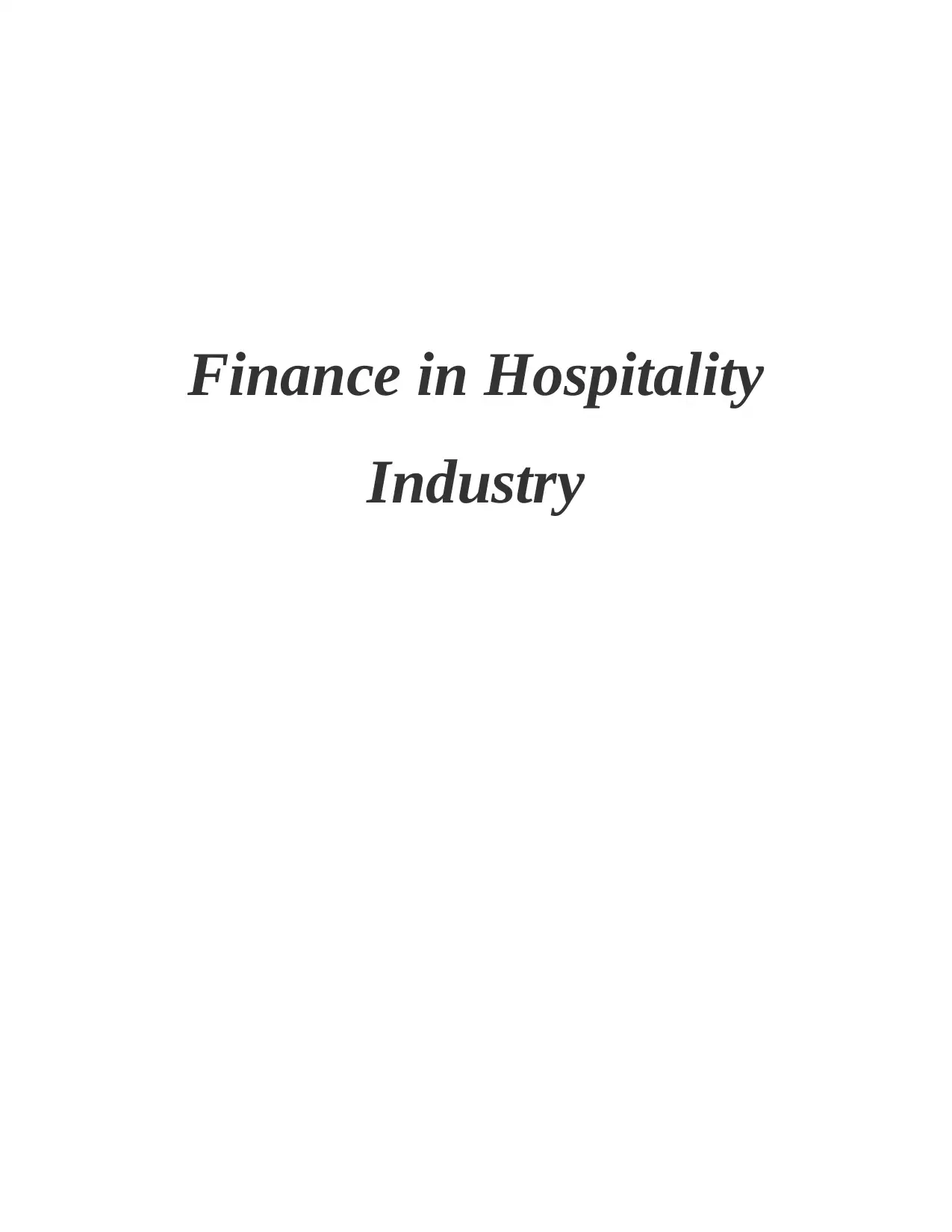
Finance in Hospitality
Industry
Industry
Paraphrase This Document
Need a fresh take? Get an instant paraphrase of this document with our AI Paraphraser
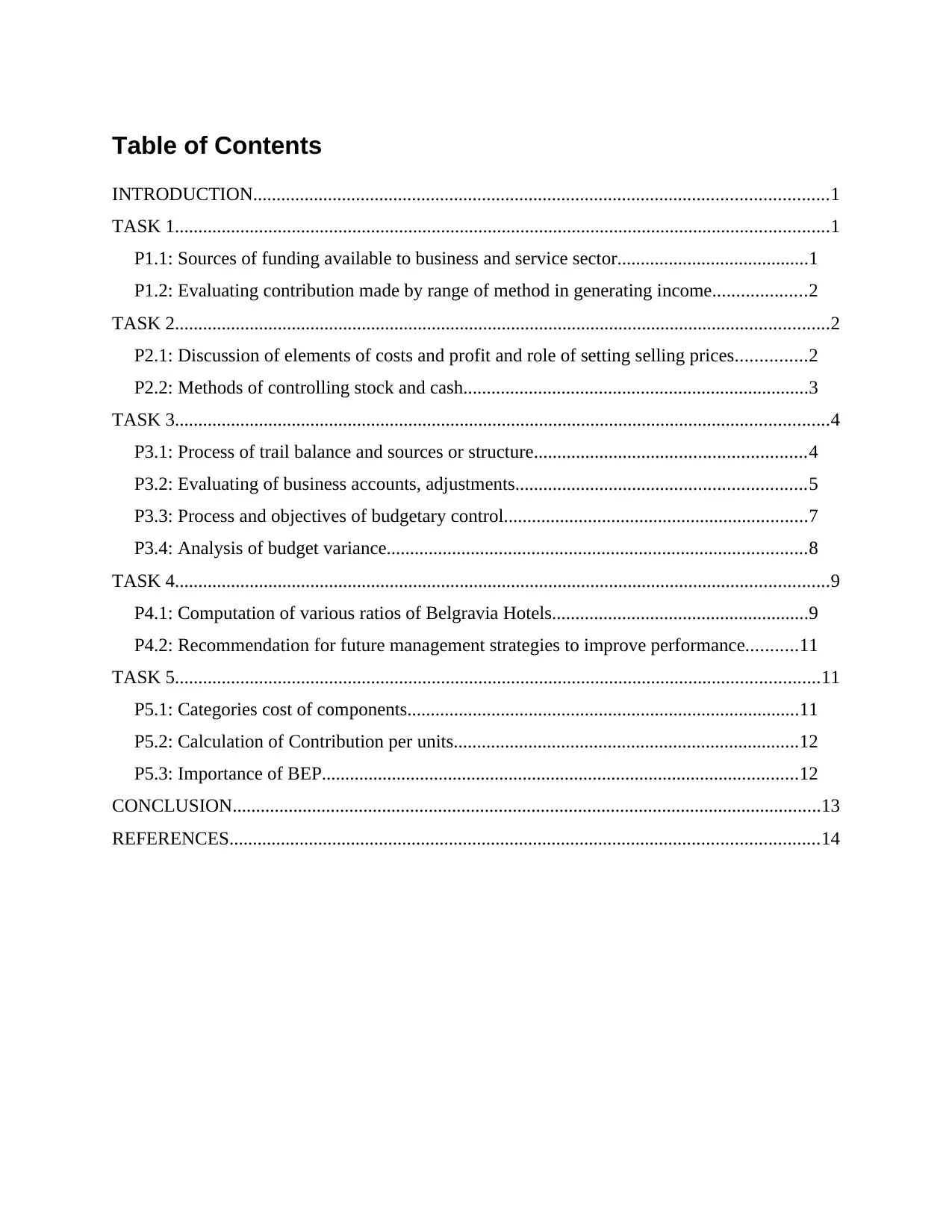
Table of Contents
INTRODUCTION...........................................................................................................................1
TASK 1............................................................................................................................................1
P1.1: Sources of funding available to business and service sector.........................................1
P1.2: Evaluating contribution made by range of method in generating income....................2
TASK 2............................................................................................................................................2
P2.1: Discussion of elements of costs and profit and role of setting selling prices...............2
P2.2: Methods of controlling stock and cash..........................................................................3
TASK 3............................................................................................................................................4
P3.1: Process of trail balance and sources or structure..........................................................4
P3.2: Evaluating of business accounts, adjustments..............................................................5
P3.3: Process and objectives of budgetary control.................................................................7
P3.4: Analysis of budget variance..........................................................................................8
TASK 4............................................................................................................................................9
P4.1: Computation of various ratios of Belgravia Hotels.......................................................9
P4.2: Recommendation for future management strategies to improve performance...........11
TASK 5..........................................................................................................................................11
P5.1: Categories cost of components....................................................................................11
P5.2: Calculation of Contribution per units..........................................................................12
P5.3: Importance of BEP......................................................................................................12
CONCLUSION..............................................................................................................................13
REFERENCES..............................................................................................................................14
INTRODUCTION...........................................................................................................................1
TASK 1............................................................................................................................................1
P1.1: Sources of funding available to business and service sector.........................................1
P1.2: Evaluating contribution made by range of method in generating income....................2
TASK 2............................................................................................................................................2
P2.1: Discussion of elements of costs and profit and role of setting selling prices...............2
P2.2: Methods of controlling stock and cash..........................................................................3
TASK 3............................................................................................................................................4
P3.1: Process of trail balance and sources or structure..........................................................4
P3.2: Evaluating of business accounts, adjustments..............................................................5
P3.3: Process and objectives of budgetary control.................................................................7
P3.4: Analysis of budget variance..........................................................................................8
TASK 4............................................................................................................................................9
P4.1: Computation of various ratios of Belgravia Hotels.......................................................9
P4.2: Recommendation for future management strategies to improve performance...........11
TASK 5..........................................................................................................................................11
P5.1: Categories cost of components....................................................................................11
P5.2: Calculation of Contribution per units..........................................................................12
P5.3: Importance of BEP......................................................................................................12
CONCLUSION..............................................................................................................................13
REFERENCES..............................................................................................................................14
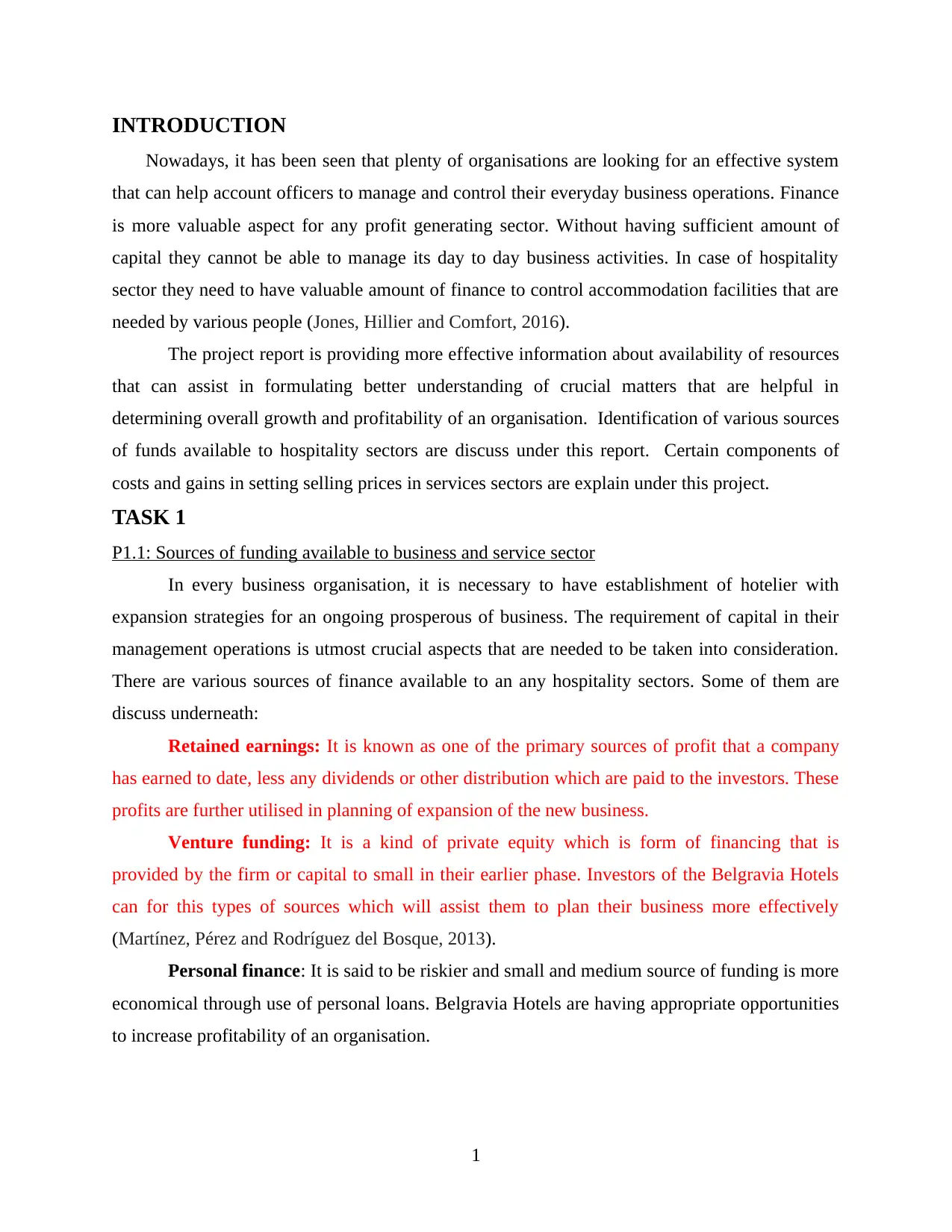
INTRODUCTION
Nowadays, it has been seen that plenty of organisations are looking for an effective system
that can help account officers to manage and control their everyday business operations. Finance
is more valuable aspect for any profit generating sector. Without having sufficient amount of
capital they cannot be able to manage its day to day business activities. In case of hospitality
sector they need to have valuable amount of finance to control accommodation facilities that are
needed by various people (Jones, Hillier and Comfort, 2016).
The project report is providing more effective information about availability of resources
that can assist in formulating better understanding of crucial matters that are helpful in
determining overall growth and profitability of an organisation. Identification of various sources
of funds available to hospitality sectors are discuss under this report. Certain components of
costs and gains in setting selling prices in services sectors are explain under this project.
TASK 1
P1.1: Sources of funding available to business and service sector
In every business organisation, it is necessary to have establishment of hotelier with
expansion strategies for an ongoing prosperous of business. The requirement of capital in their
management operations is utmost crucial aspects that are needed to be taken into consideration.
There are various sources of finance available to an any hospitality sectors. Some of them are
discuss underneath:
Retained earnings: It is known as one of the primary sources of profit that a company
has earned to date, less any dividends or other distribution which are paid to the investors. These
profits are further utilised in planning of expansion of the new business.
Venture funding: It is a kind of private equity which is form of financing that is
provided by the firm or capital to small in their earlier phase. Investors of the Belgravia Hotels
can for this types of sources which will assist them to plan their business more effectively
(Martínez, Pérez and Rodríguez del Bosque, 2013).
Personal finance: It is said to be riskier and small and medium source of funding is more
economical through use of personal loans. Belgravia Hotels are having appropriate opportunities
to increase profitability of an organisation.
1
Nowadays, it has been seen that plenty of organisations are looking for an effective system
that can help account officers to manage and control their everyday business operations. Finance
is more valuable aspect for any profit generating sector. Without having sufficient amount of
capital they cannot be able to manage its day to day business activities. In case of hospitality
sector they need to have valuable amount of finance to control accommodation facilities that are
needed by various people (Jones, Hillier and Comfort, 2016).
The project report is providing more effective information about availability of resources
that can assist in formulating better understanding of crucial matters that are helpful in
determining overall growth and profitability of an organisation. Identification of various sources
of funds available to hospitality sectors are discuss under this report. Certain components of
costs and gains in setting selling prices in services sectors are explain under this project.
TASK 1
P1.1: Sources of funding available to business and service sector
In every business organisation, it is necessary to have establishment of hotelier with
expansion strategies for an ongoing prosperous of business. The requirement of capital in their
management operations is utmost crucial aspects that are needed to be taken into consideration.
There are various sources of finance available to an any hospitality sectors. Some of them are
discuss underneath:
Retained earnings: It is known as one of the primary sources of profit that a company
has earned to date, less any dividends or other distribution which are paid to the investors. These
profits are further utilised in planning of expansion of the new business.
Venture funding: It is a kind of private equity which is form of financing that is
provided by the firm or capital to small in their earlier phase. Investors of the Belgravia Hotels
can for this types of sources which will assist them to plan their business more effectively
(Martínez, Pérez and Rodríguez del Bosque, 2013).
Personal finance: It is said to be riskier and small and medium source of funding is more
economical through use of personal loans. Belgravia Hotels are having appropriate opportunities
to increase profitability of an organisation.
1
⊘ This is a preview!⊘
Do you want full access?
Subscribe today to unlock all pages.

Trusted by 1+ million students worldwide
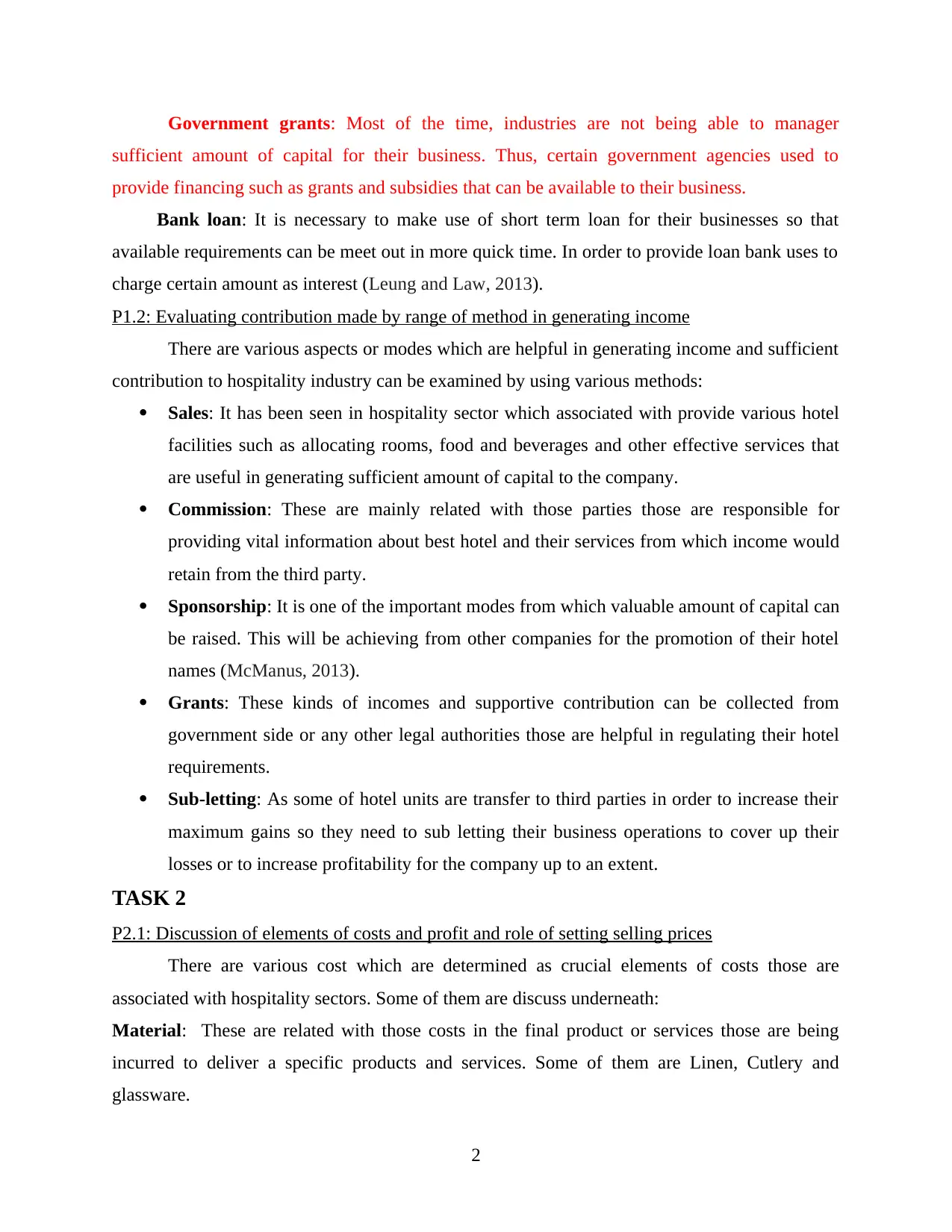
Government grants: Most of the time, industries are not being able to manager
sufficient amount of capital for their business. Thus, certain government agencies used to
provide financing such as grants and subsidies that can be available to their business.
Bank loan: It is necessary to make use of short term loan for their businesses so that
available requirements can be meet out in more quick time. In order to provide loan bank uses to
charge certain amount as interest (Leung and Law, 2013).
P1.2: Evaluating contribution made by range of method in generating income
There are various aspects or modes which are helpful in generating income and sufficient
contribution to hospitality industry can be examined by using various methods:
Sales: It has been seen in hospitality sector which associated with provide various hotel
facilities such as allocating rooms, food and beverages and other effective services that
are useful in generating sufficient amount of capital to the company.
Commission: These are mainly related with those parties those are responsible for
providing vital information about best hotel and their services from which income would
retain from the third party.
Sponsorship: It is one of the important modes from which valuable amount of capital can
be raised. This will be achieving from other companies for the promotion of their hotel
names (McManus, 2013).
Grants: These kinds of incomes and supportive contribution can be collected from
government side or any other legal authorities those are helpful in regulating their hotel
requirements.
Sub-letting: As some of hotel units are transfer to third parties in order to increase their
maximum gains so they need to sub letting their business operations to cover up their
losses or to increase profitability for the company up to an extent.
TASK 2
P2.1: Discussion of elements of costs and profit and role of setting selling prices
There are various cost which are determined as crucial elements of costs those are
associated with hospitality sectors. Some of them are discuss underneath:
Material: These are related with those costs in the final product or services those are being
incurred to deliver a specific products and services. Some of them are Linen, Cutlery and
glassware.
2
sufficient amount of capital for their business. Thus, certain government agencies used to
provide financing such as grants and subsidies that can be available to their business.
Bank loan: It is necessary to make use of short term loan for their businesses so that
available requirements can be meet out in more quick time. In order to provide loan bank uses to
charge certain amount as interest (Leung and Law, 2013).
P1.2: Evaluating contribution made by range of method in generating income
There are various aspects or modes which are helpful in generating income and sufficient
contribution to hospitality industry can be examined by using various methods:
Sales: It has been seen in hospitality sector which associated with provide various hotel
facilities such as allocating rooms, food and beverages and other effective services that
are useful in generating sufficient amount of capital to the company.
Commission: These are mainly related with those parties those are responsible for
providing vital information about best hotel and their services from which income would
retain from the third party.
Sponsorship: It is one of the important modes from which valuable amount of capital can
be raised. This will be achieving from other companies for the promotion of their hotel
names (McManus, 2013).
Grants: These kinds of incomes and supportive contribution can be collected from
government side or any other legal authorities those are helpful in regulating their hotel
requirements.
Sub-letting: As some of hotel units are transfer to third parties in order to increase their
maximum gains so they need to sub letting their business operations to cover up their
losses or to increase profitability for the company up to an extent.
TASK 2
P2.1: Discussion of elements of costs and profit and role of setting selling prices
There are various cost which are determined as crucial elements of costs those are
associated with hospitality sectors. Some of them are discuss underneath:
Material: These are related with those costs in the final product or services those are being
incurred to deliver a specific products and services. Some of them are Linen, Cutlery and
glassware.
2
Paraphrase This Document
Need a fresh take? Get an instant paraphrase of this document with our AI Paraphraser
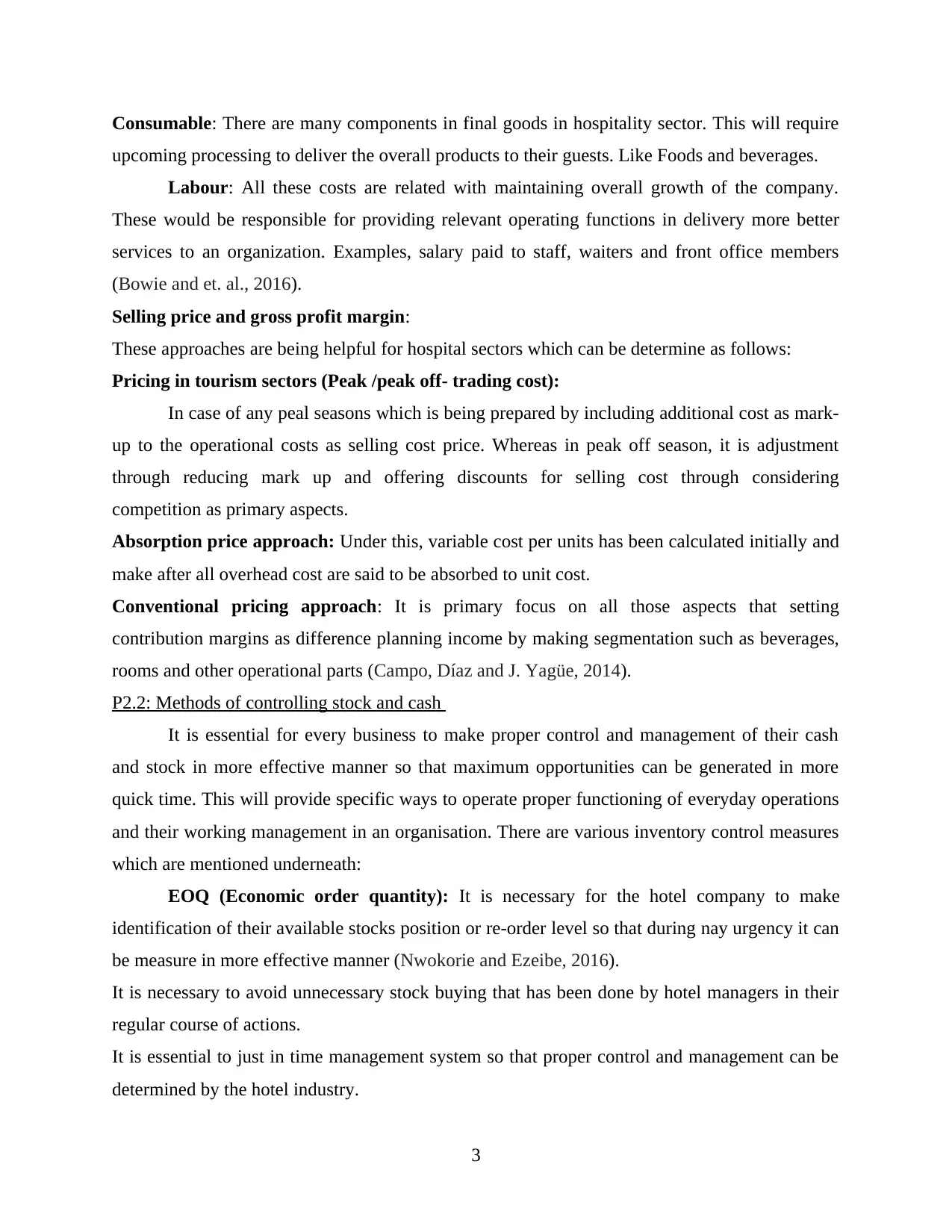
Consumable: There are many components in final goods in hospitality sector. This will require
upcoming processing to deliver the overall products to their guests. Like Foods and beverages.
Labour: All these costs are related with maintaining overall growth of the company.
These would be responsible for providing relevant operating functions in delivery more better
services to an organization. Examples, salary paid to staff, waiters and front office members
(Bowie and et. al., 2016).
Selling price and gross profit margin:
These approaches are being helpful for hospital sectors which can be determine as follows:
Pricing in tourism sectors (Peak /peak off- trading cost):
In case of any peal seasons which is being prepared by including additional cost as mark-
up to the operational costs as selling cost price. Whereas in peak off season, it is adjustment
through reducing mark up and offering discounts for selling cost through considering
competition as primary aspects.
Absorption price approach: Under this, variable cost per units has been calculated initially and
make after all overhead cost are said to be absorbed to unit cost.
Conventional pricing approach: It is primary focus on all those aspects that setting
contribution margins as difference planning income by making segmentation such as beverages,
rooms and other operational parts (Campo, Díaz and J. Yagüe, 2014).
P2.2: Methods of controlling stock and cash
It is essential for every business to make proper control and management of their cash
and stock in more effective manner so that maximum opportunities can be generated in more
quick time. This will provide specific ways to operate proper functioning of everyday operations
and their working management in an organisation. There are various inventory control measures
which are mentioned underneath:
EOQ (Economic order quantity): It is necessary for the hotel company to make
identification of their available stocks position or re-order level so that during nay urgency it can
be measure in more effective manner (Nwokorie and Ezeibe, 2016).
It is necessary to avoid unnecessary stock buying that has been done by hotel managers in their
regular course of actions.
It is essential to just in time management system so that proper control and management can be
determined by the hotel industry.
3
upcoming processing to deliver the overall products to their guests. Like Foods and beverages.
Labour: All these costs are related with maintaining overall growth of the company.
These would be responsible for providing relevant operating functions in delivery more better
services to an organization. Examples, salary paid to staff, waiters and front office members
(Bowie and et. al., 2016).
Selling price and gross profit margin:
These approaches are being helpful for hospital sectors which can be determine as follows:
Pricing in tourism sectors (Peak /peak off- trading cost):
In case of any peal seasons which is being prepared by including additional cost as mark-
up to the operational costs as selling cost price. Whereas in peak off season, it is adjustment
through reducing mark up and offering discounts for selling cost through considering
competition as primary aspects.
Absorption price approach: Under this, variable cost per units has been calculated initially and
make after all overhead cost are said to be absorbed to unit cost.
Conventional pricing approach: It is primary focus on all those aspects that setting
contribution margins as difference planning income by making segmentation such as beverages,
rooms and other operational parts (Campo, Díaz and J. Yagüe, 2014).
P2.2: Methods of controlling stock and cash
It is essential for every business to make proper control and management of their cash
and stock in more effective manner so that maximum opportunities can be generated in more
quick time. This will provide specific ways to operate proper functioning of everyday operations
and their working management in an organisation. There are various inventory control measures
which are mentioned underneath:
EOQ (Economic order quantity): It is necessary for the hotel company to make
identification of their available stocks position or re-order level so that during nay urgency it can
be measure in more effective manner (Nwokorie and Ezeibe, 2016).
It is necessary to avoid unnecessary stock buying that has been done by hotel managers in their
regular course of actions.
It is essential to just in time management system so that proper control and management can be
determined by the hotel industry.
3
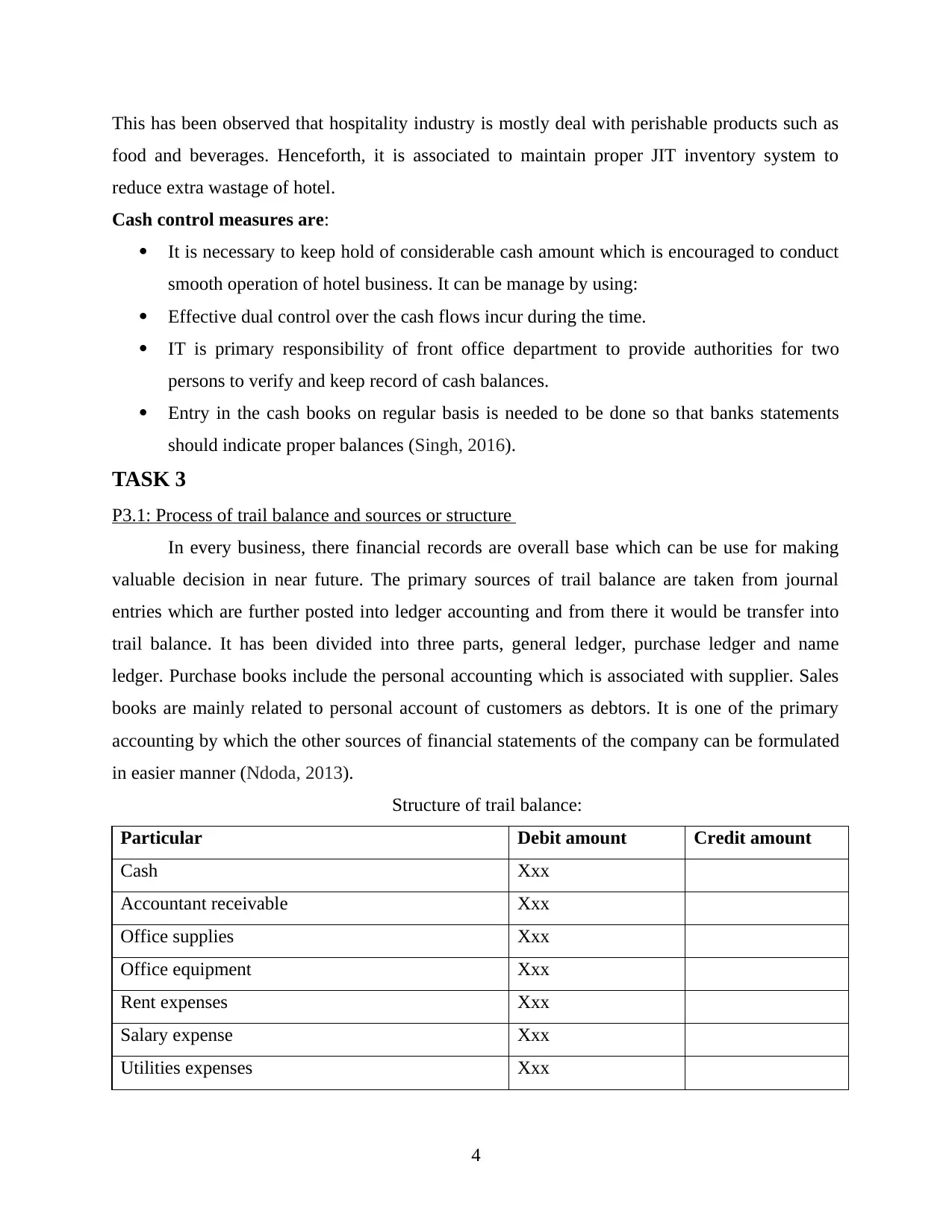
This has been observed that hospitality industry is mostly deal with perishable products such as
food and beverages. Henceforth, it is associated to maintain proper JIT inventory system to
reduce extra wastage of hotel.
Cash control measures are:
It is necessary to keep hold of considerable cash amount which is encouraged to conduct
smooth operation of hotel business. It can be manage by using:
Effective dual control over the cash flows incur during the time.
IT is primary responsibility of front office department to provide authorities for two
persons to verify and keep record of cash balances.
Entry in the cash books on regular basis is needed to be done so that banks statements
should indicate proper balances (Singh, 2016).
TASK 3
P3.1: Process of trail balance and sources or structure
In every business, there financial records are overall base which can be use for making
valuable decision in near future. The primary sources of trail balance are taken from journal
entries which are further posted into ledger accounting and from there it would be transfer into
trail balance. It has been divided into three parts, general ledger, purchase ledger and name
ledger. Purchase books include the personal accounting which is associated with supplier. Sales
books are mainly related to personal account of customers as debtors. It is one of the primary
accounting by which the other sources of financial statements of the company can be formulated
in easier manner (Ndoda, 2013).
Structure of trail balance:
Particular Debit amount Credit amount
Cash Xxx
Accountant receivable Xxx
Office supplies Xxx
Office equipment Xxx
Rent expenses Xxx
Salary expense Xxx
Utilities expenses Xxx
4
food and beverages. Henceforth, it is associated to maintain proper JIT inventory system to
reduce extra wastage of hotel.
Cash control measures are:
It is necessary to keep hold of considerable cash amount which is encouraged to conduct
smooth operation of hotel business. It can be manage by using:
Effective dual control over the cash flows incur during the time.
IT is primary responsibility of front office department to provide authorities for two
persons to verify and keep record of cash balances.
Entry in the cash books on regular basis is needed to be done so that banks statements
should indicate proper balances (Singh, 2016).
TASK 3
P3.1: Process of trail balance and sources or structure
In every business, there financial records are overall base which can be use for making
valuable decision in near future. The primary sources of trail balance are taken from journal
entries which are further posted into ledger accounting and from there it would be transfer into
trail balance. It has been divided into three parts, general ledger, purchase ledger and name
ledger. Purchase books include the personal accounting which is associated with supplier. Sales
books are mainly related to personal account of customers as debtors. It is one of the primary
accounting by which the other sources of financial statements of the company can be formulated
in easier manner (Ndoda, 2013).
Structure of trail balance:
Particular Debit amount Credit amount
Cash Xxx
Accountant receivable Xxx
Office supplies Xxx
Office equipment Xxx
Rent expenses Xxx
Salary expense Xxx
Utilities expenses Xxx
4
⊘ This is a preview!⊘
Do you want full access?
Subscribe today to unlock all pages.

Trusted by 1+ million students worldwide
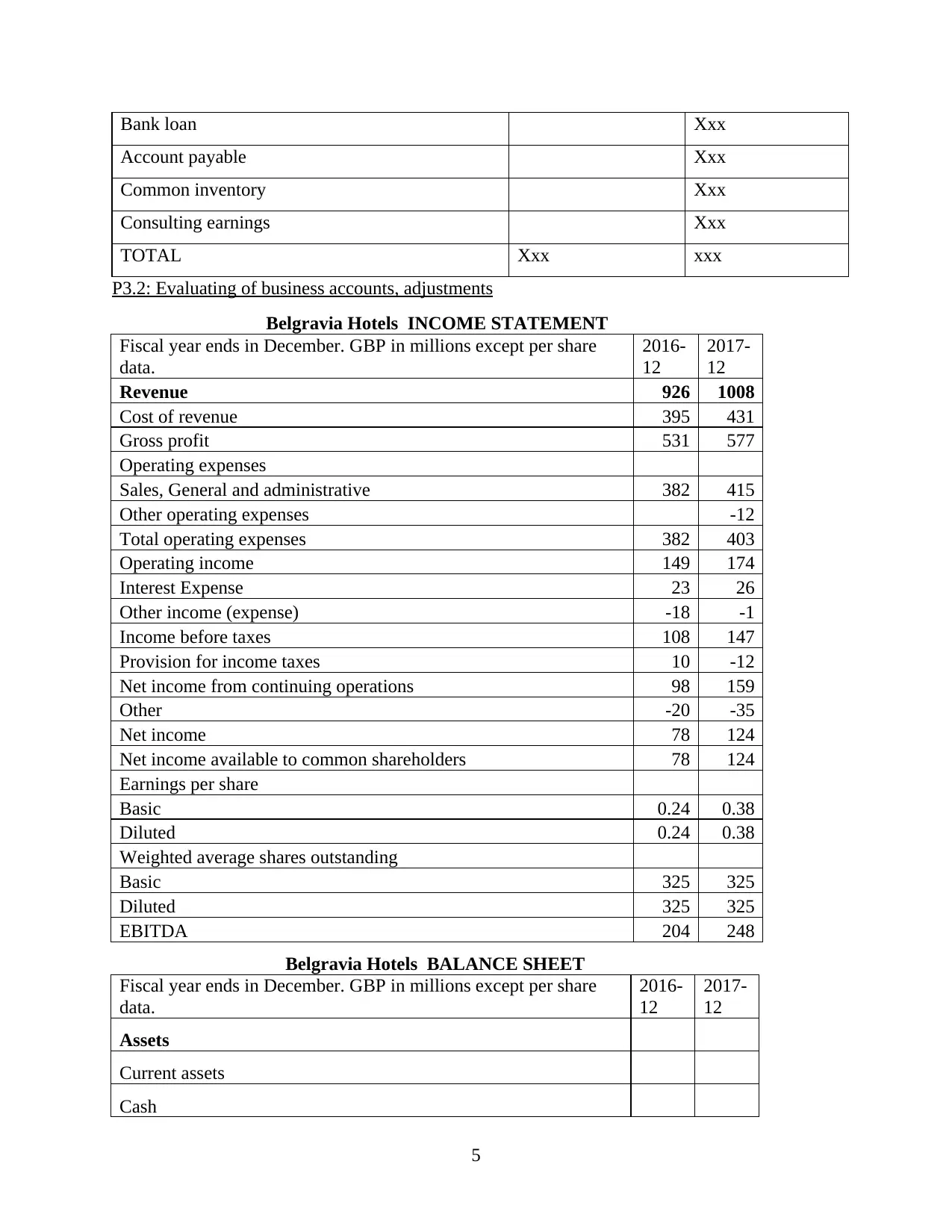
Bank loan Xxx
Account payable Xxx
Common inventory Xxx
Consulting earnings Xxx
TOTAL Xxx xxx
P3.2: Evaluating of business accounts, adjustments
Belgravia Hotels INCOME STATEMENT
Fiscal year ends in December. GBP in millions except per share
data.
2016-
12
2017-
12
Revenue 926 1008
Cost of revenue 395 431
Gross profit 531 577
Operating expenses
Sales, General and administrative 382 415
Other operating expenses -12
Total operating expenses 382 403
Operating income 149 174
Interest Expense 23 26
Other income (expense) -18 -1
Income before taxes 108 147
Provision for income taxes 10 -12
Net income from continuing operations 98 159
Other -20 -35
Net income 78 124
Net income available to common shareholders 78 124
Earnings per share
Basic 0.24 0.38
Diluted 0.24 0.38
Weighted average shares outstanding
Basic 325 325
Diluted 325 325
EBITDA 204 248
Belgravia Hotels BALANCE SHEET
Fiscal year ends in December. GBP in millions except per share
data.
2016-
12
2017-
12
Assets
Current assets
Cash
5
Account payable Xxx
Common inventory Xxx
Consulting earnings Xxx
TOTAL Xxx xxx
P3.2: Evaluating of business accounts, adjustments
Belgravia Hotels INCOME STATEMENT
Fiscal year ends in December. GBP in millions except per share
data.
2016-
12
2017-
12
Revenue 926 1008
Cost of revenue 395 431
Gross profit 531 577
Operating expenses
Sales, General and administrative 382 415
Other operating expenses -12
Total operating expenses 382 403
Operating income 149 174
Interest Expense 23 26
Other income (expense) -18 -1
Income before taxes 108 147
Provision for income taxes 10 -12
Net income from continuing operations 98 159
Other -20 -35
Net income 78 124
Net income available to common shareholders 78 124
Earnings per share
Basic 0.24 0.38
Diluted 0.24 0.38
Weighted average shares outstanding
Basic 325 325
Diluted 325 325
EBITDA 204 248
Belgravia Hotels BALANCE SHEET
Fiscal year ends in December. GBP in millions except per share
data.
2016-
12
2017-
12
Assets
Current assets
Cash
5
Paraphrase This Document
Need a fresh take? Get an instant paraphrase of this document with our AI Paraphraser
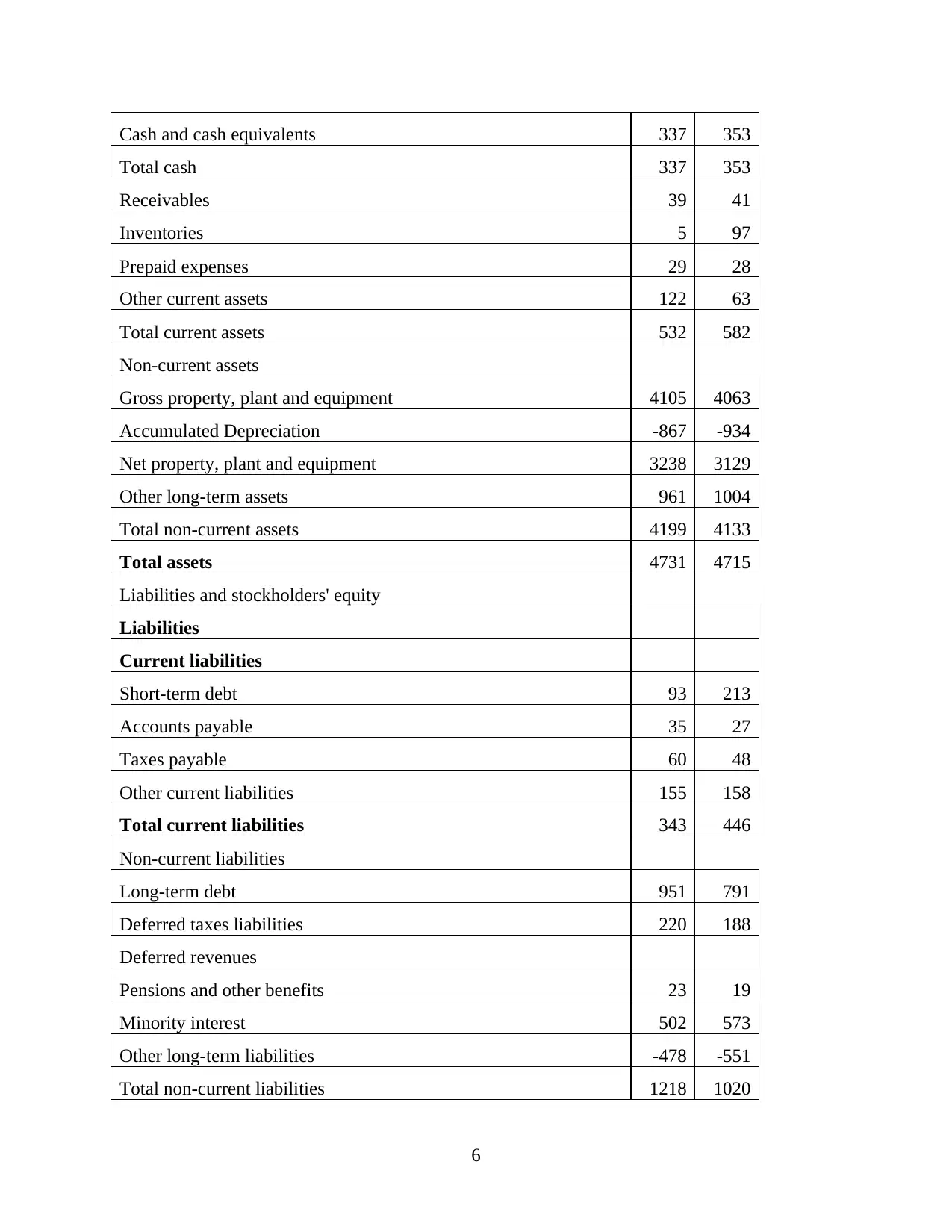
Cash and cash equivalents 337 353
Total cash 337 353
Receivables 39 41
Inventories 5 97
Prepaid expenses 29 28
Other current assets 122 63
Total current assets 532 582
Non-current assets
Gross property, plant and equipment 4105 4063
Accumulated Depreciation -867 -934
Net property, plant and equipment 3238 3129
Other long-term assets 961 1004
Total non-current assets 4199 4133
Total assets 4731 4715
Liabilities and stockholders' equity
Liabilities
Current liabilities
Short-term debt 93 213
Accounts payable 35 27
Taxes payable 60 48
Other current liabilities 155 158
Total current liabilities 343 446
Non-current liabilities
Long-term debt 951 791
Deferred taxes liabilities 220 188
Deferred revenues
Pensions and other benefits 23 19
Minority interest 502 573
Other long-term liabilities -478 -551
Total non-current liabilities 1218 1020
6
Total cash 337 353
Receivables 39 41
Inventories 5 97
Prepaid expenses 29 28
Other current assets 122 63
Total current assets 532 582
Non-current assets
Gross property, plant and equipment 4105 4063
Accumulated Depreciation -867 -934
Net property, plant and equipment 3238 3129
Other long-term assets 961 1004
Total non-current assets 4199 4133
Total assets 4731 4715
Liabilities and stockholders' equity
Liabilities
Current liabilities
Short-term debt 93 213
Accounts payable 35 27
Taxes payable 60 48
Other current liabilities 155 158
Total current liabilities 343 446
Non-current liabilities
Long-term debt 951 791
Deferred taxes liabilities 220 188
Deferred revenues
Pensions and other benefits 23 19
Minority interest 502 573
Other long-term liabilities -478 -551
Total non-current liabilities 1218 1020
6
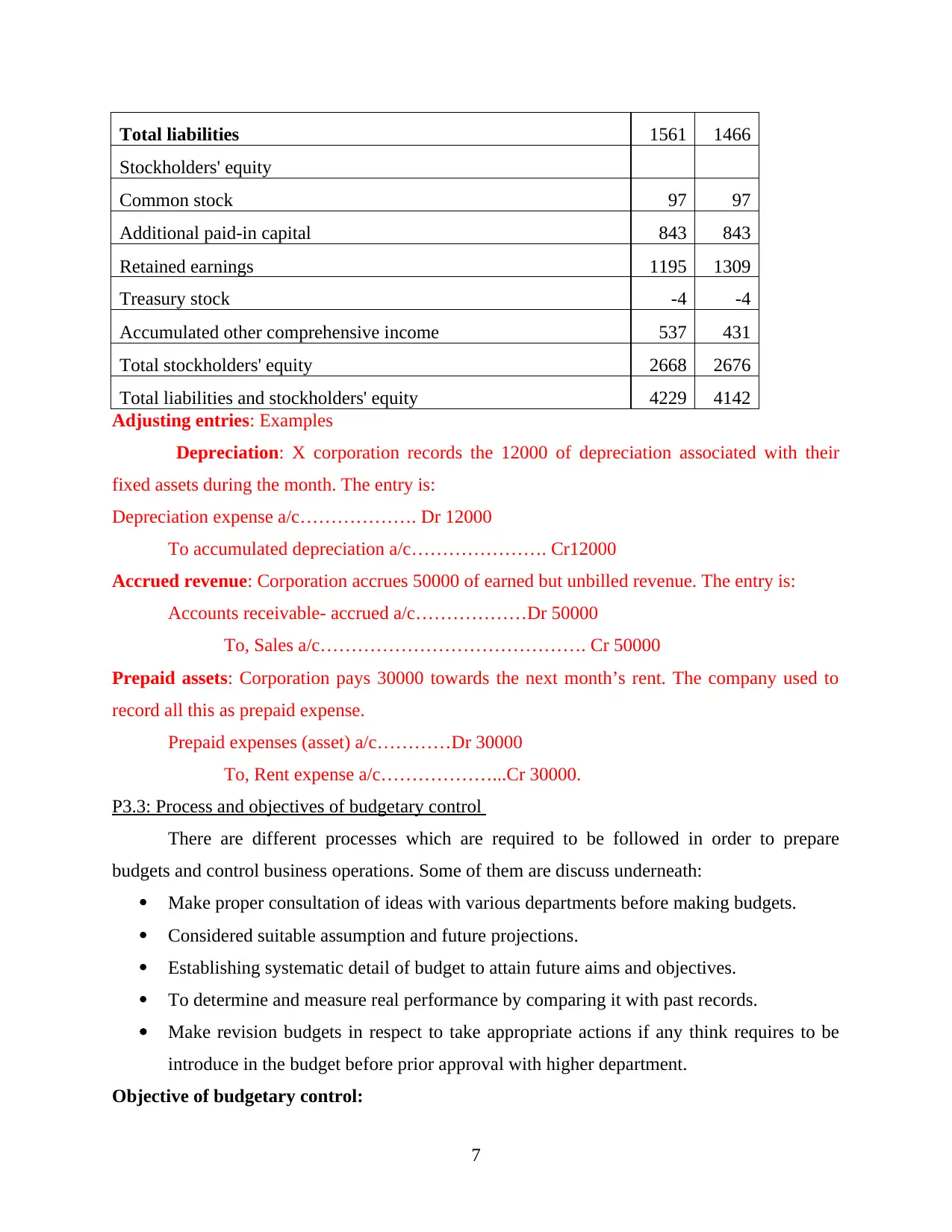
Total liabilities 1561 1466
Stockholders' equity
Common stock 97 97
Additional paid-in capital 843 843
Retained earnings 1195 1309
Treasury stock -4 -4
Accumulated other comprehensive income 537 431
Total stockholders' equity 2668 2676
Total liabilities and stockholders' equity 4229 4142
Adjusting entries: Examples
Depreciation: X corporation records the 12000 of depreciation associated with their
fixed assets during the month. The entry is:
Depreciation expense a/c………………. Dr 12000
To accumulated depreciation a/c…………………. Cr12000
Accrued revenue: Corporation accrues 50000 of earned but unbilled revenue. The entry is:
Accounts receivable- accrued a/c………………Dr 50000
To, Sales a/c……………………………………. Cr 50000
Prepaid assets: Corporation pays 30000 towards the next month’s rent. The company used to
record all this as prepaid expense.
Prepaid expenses (asset) a/c…………Dr 30000
To, Rent expense a/c………………...Cr 30000.
P3.3: Process and objectives of budgetary control
There are different processes which are required to be followed in order to prepare
budgets and control business operations. Some of them are discuss underneath:
Make proper consultation of ideas with various departments before making budgets.
Considered suitable assumption and future projections.
Establishing systematic detail of budget to attain future aims and objectives.
To determine and measure real performance by comparing it with past records.
Make revision budgets in respect to take appropriate actions if any think requires to be
introduce in the budget before prior approval with higher department.
Objective of budgetary control:
7
Stockholders' equity
Common stock 97 97
Additional paid-in capital 843 843
Retained earnings 1195 1309
Treasury stock -4 -4
Accumulated other comprehensive income 537 431
Total stockholders' equity 2668 2676
Total liabilities and stockholders' equity 4229 4142
Adjusting entries: Examples
Depreciation: X corporation records the 12000 of depreciation associated with their
fixed assets during the month. The entry is:
Depreciation expense a/c………………. Dr 12000
To accumulated depreciation a/c…………………. Cr12000
Accrued revenue: Corporation accrues 50000 of earned but unbilled revenue. The entry is:
Accounts receivable- accrued a/c………………Dr 50000
To, Sales a/c……………………………………. Cr 50000
Prepaid assets: Corporation pays 30000 towards the next month’s rent. The company used to
record all this as prepaid expense.
Prepaid expenses (asset) a/c…………Dr 30000
To, Rent expense a/c………………...Cr 30000.
P3.3: Process and objectives of budgetary control
There are different processes which are required to be followed in order to prepare
budgets and control business operations. Some of them are discuss underneath:
Make proper consultation of ideas with various departments before making budgets.
Considered suitable assumption and future projections.
Establishing systematic detail of budget to attain future aims and objectives.
To determine and measure real performance by comparing it with past records.
Make revision budgets in respect to take appropriate actions if any think requires to be
introduce in the budget before prior approval with higher department.
Objective of budgetary control:
7
⊘ This is a preview!⊘
Do you want full access?
Subscribe today to unlock all pages.

Trusted by 1+ million students worldwide
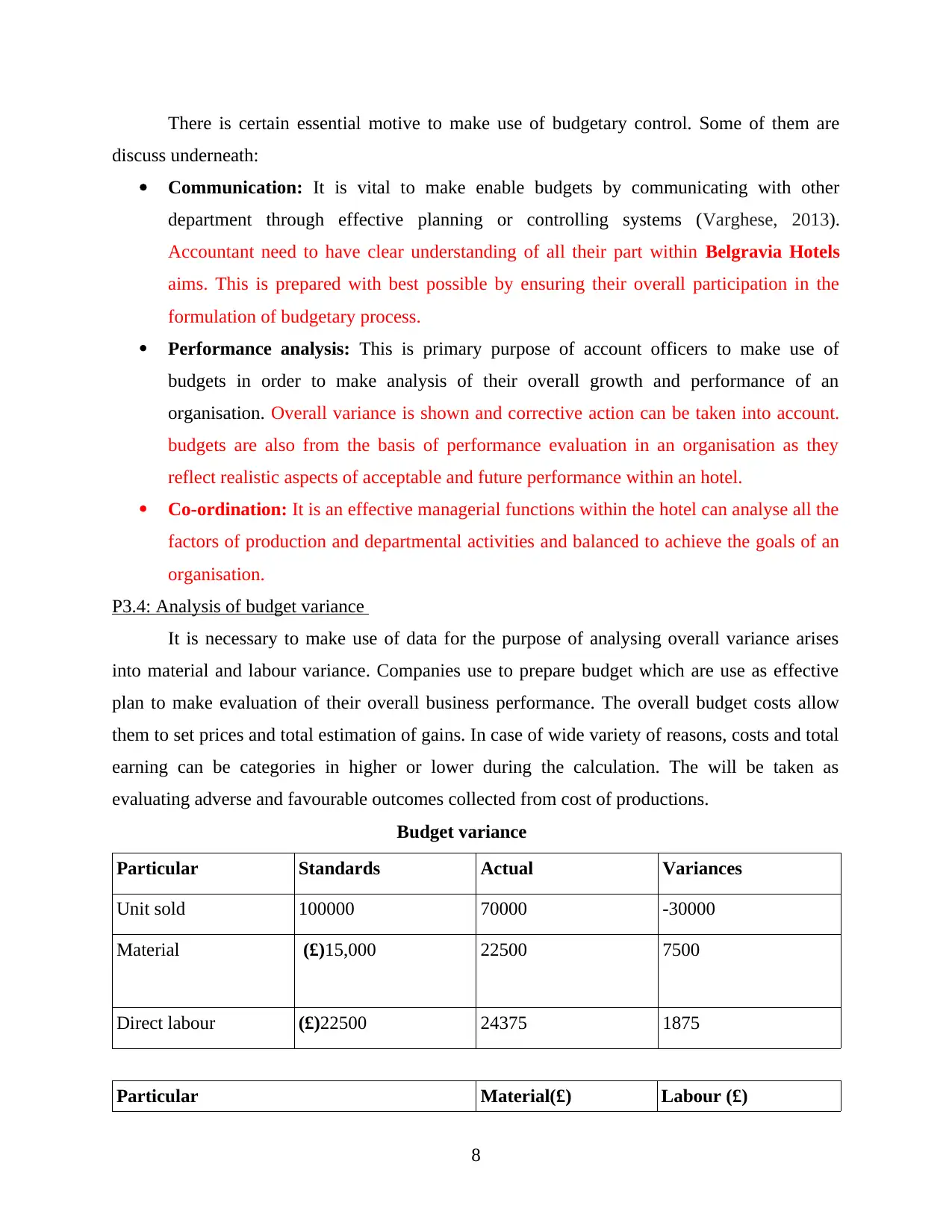
There is certain essential motive to make use of budgetary control. Some of them are
discuss underneath:
Communication: It is vital to make enable budgets by communicating with other
department through effective planning or controlling systems (Varghese, 2013).
Accountant need to have clear understanding of all their part within Belgravia Hotels
aims. This is prepared with best possible by ensuring their overall participation in the
formulation of budgetary process.
Performance analysis: This is primary purpose of account officers to make use of
budgets in order to make analysis of their overall growth and performance of an
organisation. Overall variance is shown and corrective action can be taken into account.
budgets are also from the basis of performance evaluation in an organisation as they
reflect realistic aspects of acceptable and future performance within an hotel.
Co-ordination: It is an effective managerial functions within the hotel can analyse all the
factors of production and departmental activities and balanced to achieve the goals of an
organisation.
P3.4: Analysis of budget variance
It is necessary to make use of data for the purpose of analysing overall variance arises
into material and labour variance. Companies use to prepare budget which are use as effective
plan to make evaluation of their overall business performance. The overall budget costs allow
them to set prices and total estimation of gains. In case of wide variety of reasons, costs and total
earning can be categories in higher or lower during the calculation. The will be taken as
evaluating adverse and favourable outcomes collected from cost of productions.
Budget variance
Particular Standards Actual Variances
Unit sold 100000 70000 -30000
Material (£)15,000 22500 7500
Direct labour (£)22500 24375 1875
Particular Material(£) Labour (£)
8
discuss underneath:
Communication: It is vital to make enable budgets by communicating with other
department through effective planning or controlling systems (Varghese, 2013).
Accountant need to have clear understanding of all their part within Belgravia Hotels
aims. This is prepared with best possible by ensuring their overall participation in the
formulation of budgetary process.
Performance analysis: This is primary purpose of account officers to make use of
budgets in order to make analysis of their overall growth and performance of an
organisation. Overall variance is shown and corrective action can be taken into account.
budgets are also from the basis of performance evaluation in an organisation as they
reflect realistic aspects of acceptable and future performance within an hotel.
Co-ordination: It is an effective managerial functions within the hotel can analyse all the
factors of production and departmental activities and balanced to achieve the goals of an
organisation.
P3.4: Analysis of budget variance
It is necessary to make use of data for the purpose of analysing overall variance arises
into material and labour variance. Companies use to prepare budget which are use as effective
plan to make evaluation of their overall business performance. The overall budget costs allow
them to set prices and total estimation of gains. In case of wide variety of reasons, costs and total
earning can be categories in higher or lower during the calculation. The will be taken as
evaluating adverse and favourable outcomes collected from cost of productions.
Budget variance
Particular Standards Actual Variances
Unit sold 100000 70000 -30000
Material (£)15,000 22500 7500
Direct labour (£)22500 24375 1875
Particular Material(£) Labour (£)
8
Paraphrase This Document
Need a fresh take? Get an instant paraphrase of this document with our AI Paraphraser
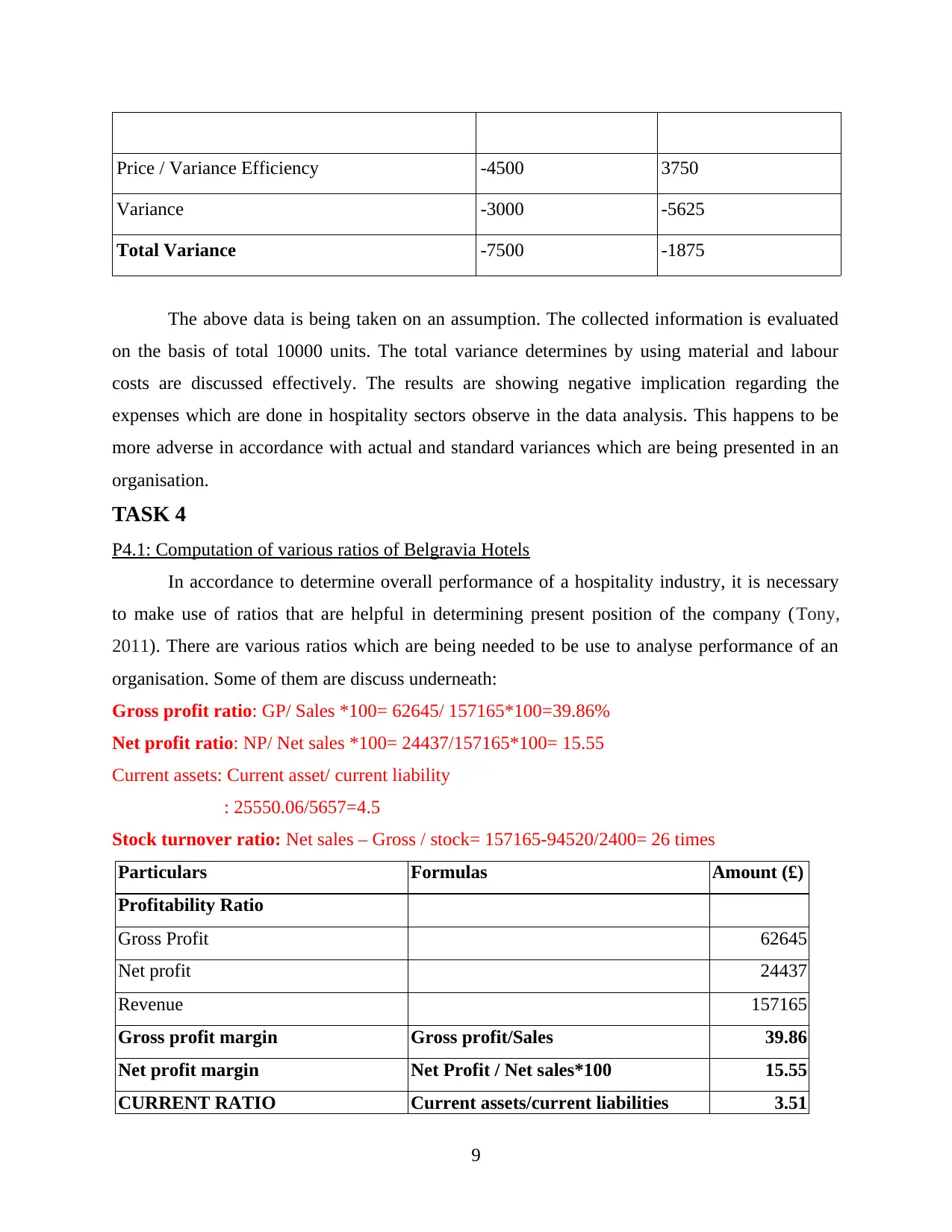
Price / Variance Efficiency -4500 3750
Variance -3000 -5625
Total Variance -7500 -1875
The above data is being taken on an assumption. The collected information is evaluated
on the basis of total 10000 units. The total variance determines by using material and labour
costs are discussed effectively. The results are showing negative implication regarding the
expenses which are done in hospitality sectors observe in the data analysis. This happens to be
more adverse in accordance with actual and standard variances which are being presented in an
organisation.
TASK 4
P4.1: Computation of various ratios of Belgravia Hotels
In accordance to determine overall performance of a hospitality industry, it is necessary
to make use of ratios that are helpful in determining present position of the company (Tony,
2011). There are various ratios which are being needed to be use to analyse performance of an
organisation. Some of them are discuss underneath:
Gross profit ratio: GP/ Sales *100= 62645/ 157165*100=39.86%
Net profit ratio: NP/ Net sales *100= 24437/157165*100= 15.55
Current assets: Current asset/ current liability
: 25550.06/5657=4.5
Stock turnover ratio: Net sales – Gross / stock= 157165-94520/2400= 26 times
Particulars Formulas Amount (£)
Profitability Ratio
Gross Profit 62645
Net profit 24437
Revenue 157165
Gross profit margin Gross profit/Sales 39.86
Net profit margin Net Profit / Net sales*100 15.55
CURRENT RATIO Current assets/current liabilities 3.51
9
Variance -3000 -5625
Total Variance -7500 -1875
The above data is being taken on an assumption. The collected information is evaluated
on the basis of total 10000 units. The total variance determines by using material and labour
costs are discussed effectively. The results are showing negative implication regarding the
expenses which are done in hospitality sectors observe in the data analysis. This happens to be
more adverse in accordance with actual and standard variances which are being presented in an
organisation.
TASK 4
P4.1: Computation of various ratios of Belgravia Hotels
In accordance to determine overall performance of a hospitality industry, it is necessary
to make use of ratios that are helpful in determining present position of the company (Tony,
2011). There are various ratios which are being needed to be use to analyse performance of an
organisation. Some of them are discuss underneath:
Gross profit ratio: GP/ Sales *100= 62645/ 157165*100=39.86%
Net profit ratio: NP/ Net sales *100= 24437/157165*100= 15.55
Current assets: Current asset/ current liability
: 25550.06/5657=4.5
Stock turnover ratio: Net sales – Gross / stock= 157165-94520/2400= 26 times
Particulars Formulas Amount (£)
Profitability Ratio
Gross Profit 62645
Net profit 24437
Revenue 157165
Gross profit margin Gross profit/Sales 39.86
Net profit margin Net Profit / Net sales*100 15.55
CURRENT RATIO Current assets/current liabilities 3.51
9
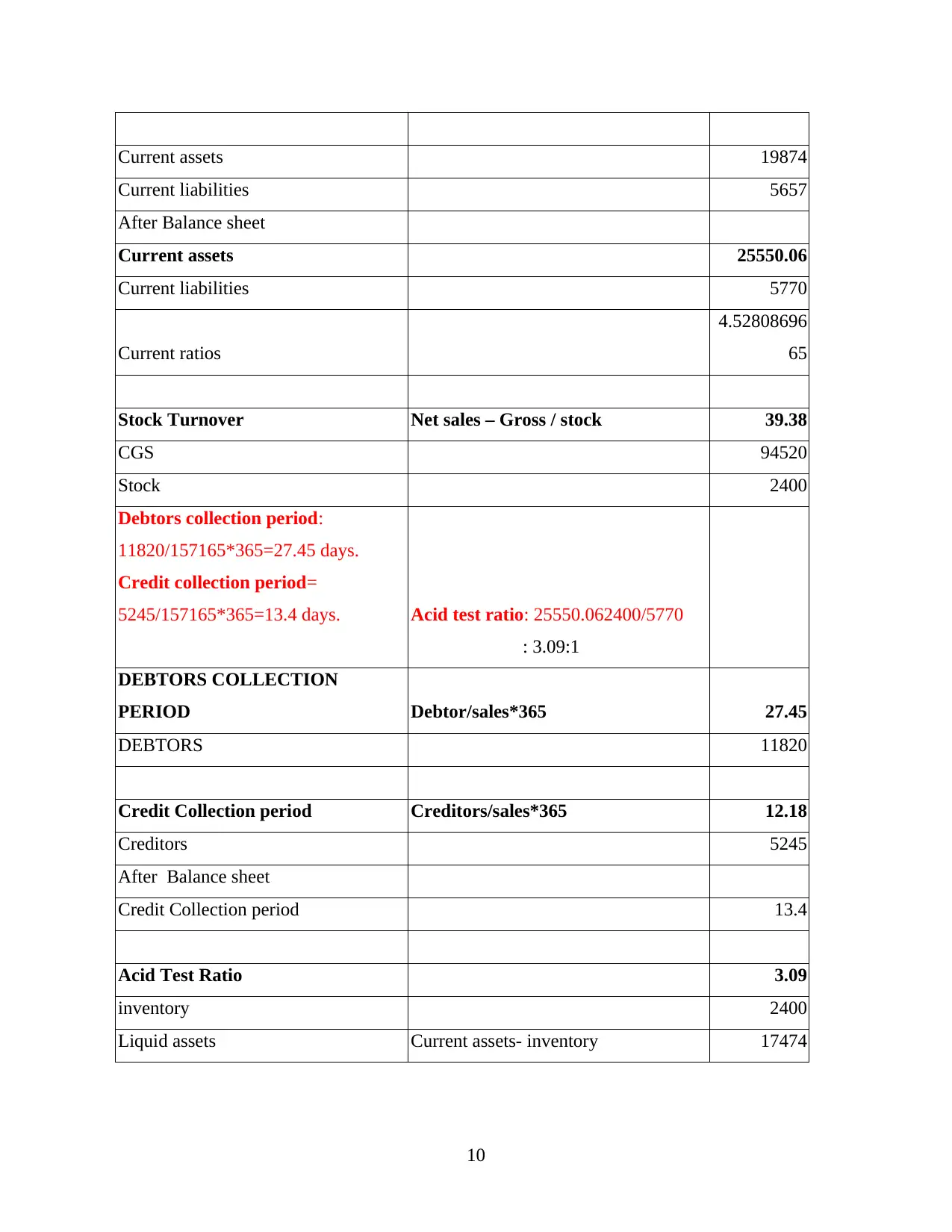
Current assets 19874
Current liabilities 5657
After Balance sheet
Current assets 25550.06
Current liabilities 5770
Current ratios
4.52808696
65
Stock Turnover Net sales – Gross / stock 39.38
CGS 94520
Stock 2400
Debtors collection period:
11820/157165*365=27.45 days.
Credit collection period=
5245/157165*365=13.4 days. Acid test ratio: 25550.062400/5770
: 3.09:1
DEBTORS COLLECTION
PERIOD Debtor/sales*365 27.45
DEBTORS 11820
Credit Collection period Creditors/sales*365 12.18
Creditors 5245
After Balance sheet
Credit Collection period 13.4
Acid Test Ratio 3.09
inventory 2400
Liquid assets Current assets- inventory 17474
10
Current liabilities 5657
After Balance sheet
Current assets 25550.06
Current liabilities 5770
Current ratios
4.52808696
65
Stock Turnover Net sales – Gross / stock 39.38
CGS 94520
Stock 2400
Debtors collection period:
11820/157165*365=27.45 days.
Credit collection period=
5245/157165*365=13.4 days. Acid test ratio: 25550.062400/5770
: 3.09:1
DEBTORS COLLECTION
PERIOD Debtor/sales*365 27.45
DEBTORS 11820
Credit Collection period Creditors/sales*365 12.18
Creditors 5245
After Balance sheet
Credit Collection period 13.4
Acid Test Ratio 3.09
inventory 2400
Liquid assets Current assets- inventory 17474
10
⊘ This is a preview!⊘
Do you want full access?
Subscribe today to unlock all pages.

Trusted by 1+ million students worldwide
1 out of 16
Related Documents
Your All-in-One AI-Powered Toolkit for Academic Success.
+13062052269
info@desklib.com
Available 24*7 on WhatsApp / Email
![[object Object]](/_next/static/media/star-bottom.7253800d.svg)
Unlock your academic potential
Copyright © 2020–2025 A2Z Services. All Rights Reserved. Developed and managed by ZUCOL.





